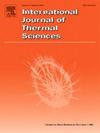Micro-CT investigation of urea crystal structures for frost analysis
IF 4.9
2区 工程技术
Q1 ENGINEERING, MECHANICAL
International Journal of Thermal Sciences
Pub Date : 2025-03-27
DOI:10.1016/j.ijthermalsci.2025.109893
引用次数: 0
Abstract
Frost formation poses a significant challenge to the design and efficiency of air-source evaporator units. To model frost formation, a detailed understanding of the evolving three-dimensional microstructures that influence thermal and mass transport properties is essential. However, direct measurement of frost microstructures remains challenging. This study demonstrates that Micro-CT, combined with finite-element modelling, is a viable method for evaluating transport properties in complex microstructures. Using urea mushy layers as a stable, non-melting analogue, we successfully validated the methodology by resolving microstructural influences on thermal conductivity and mass diffusivity.
Our results highlight the significant role of structural complexity in transport behaviour, with ‘simple’ and ‘complex’ formations influencing heat and mass transfer differently. Deviations of at least 26.6 % between measured properties and predictions from empirical bulk-property models confirm that conventional approaches fail to capture the effects of structural heterogeneity. While these findings do not directly translate to frost formation, the validated methodology offers a foundation for improving frost prediction models by incorporating high-resolution structural data, ultimately enhancing the accuracy of thermal system designs in frost-prone environments.
用于霜分析的尿素晶体结构的微ct研究
结霜对空气源蒸发器机组的设计和效率提出了重大挑战。为了模拟霜的形成,详细了解影响热和质量输运性质的三维微观结构的演变是必不可少的。然而,直接测量霜的微观结构仍然具有挑战性。该研究表明,Micro-CT结合有限元建模是评估复杂微观结构输运特性的可行方法。使用尿素糊状层作为稳定的、不熔化的类似物,我们通过解决微观结构对导热性和质量扩散率的影响,成功地验证了该方法。我们的研究结果强调了结构复杂性在传输行为中的重要作用,“简单”和“复杂”的结构对传热和传质的影响不同。实测性质与经验体积性质模型预测之间至少有26.6%的偏差,这证实了传统方法无法捕捉到结构异质性的影响。虽然这些发现并不能直接转化为结霜的形成,但经过验证的方法为通过结合高分辨率结构数据来改进结霜预测模型提供了基础,最终提高了易结霜环境中热系统设计的准确性。
本文章由计算机程序翻译,如有差异,请以英文原文为准。
求助全文
约1分钟内获得全文
求助全文
来源期刊

International Journal of Thermal Sciences
工程技术-工程:机械
CiteScore
8.10
自引率
11.10%
发文量
531
审稿时长
55 days
期刊介绍:
The International Journal of Thermal Sciences is a journal devoted to the publication of fundamental studies on the physics of transfer processes in general, with an emphasis on thermal aspects and also applied research on various processes, energy systems and the environment. Articles are published in English and French, and are subject to peer review.
The fundamental subjects considered within the scope of the journal are:
* Heat and relevant mass transfer at all scales (nano, micro and macro) and in all types of material (heterogeneous, composites, biological,...) and fluid flow
* Forced, natural or mixed convection in reactive or non-reactive media
* Single or multi–phase fluid flow with or without phase change
* Near–and far–field radiative heat transfer
* Combined modes of heat transfer in complex systems (for example, plasmas, biological, geological,...)
* Multiscale modelling
The applied research topics include:
* Heat exchangers, heat pipes, cooling processes
* Transport phenomena taking place in industrial processes (chemical, food and agricultural, metallurgical, space and aeronautical, automobile industries)
* Nano–and micro–technology for energy, space, biosystems and devices
* Heat transport analysis in advanced systems
* Impact of energy–related processes on environment, and emerging energy systems
The study of thermophysical properties of materials and fluids, thermal measurement techniques, inverse methods, and the developments of experimental methods are within the scope of the International Journal of Thermal Sciences which also covers the modelling, and numerical methods applied to thermal transfer.
 求助内容:
求助内容: 应助结果提醒方式:
应助结果提醒方式:


